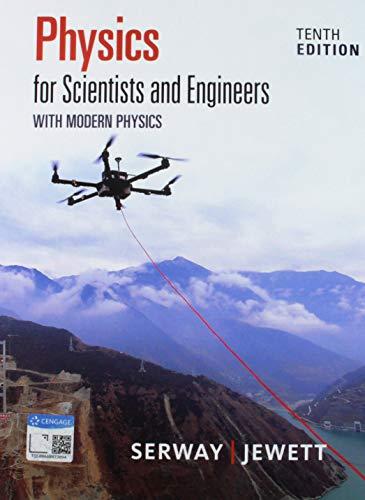
Concept explainers
(a)
Prove that the quantized radii of Earth’s orbit is
(a)
Answer to Problem 42AP
It is proved that the quantized radii of Earth’s orbit is
Explanation of Solution
The gravitational force between Earth and sun is balanced by the
Write the relation between gravitational force between Earth and sun and the centripetal force at equilibrium.
Here,
Write the equation for quantization of angular momentum of Earth.
Rewrite the above relation in terms of
Rewrite equation (I) by substituting the above relation for
Rewrite the above relation inn terms of
Therefore, it is proved that the quantized radii of Earth’s orbit are
(b)
The numerical value of
(b)
Answer to Problem 42AP
The numerical value of
Explanation of Solution
Rewrite equation (II) in terms of
Conclusion:
Substitute
Therefore, the numerical value of
(c)
The distance between orbits corresponding to quantum number
(c)
Answer to Problem 42AP
The distance between orbits corresponding to quantum number
Explanation of Solution
Write equation (II) for the radius corresponding to quantum number
Here,
Rewrite the above equation by substituting
Here,
Subtract equation (III) from equation (IV) to find the separation between orbits.
Neglect the value
Conclusion:
Substitute
Therefore, the distance between orbits corresponding to quantum number
(d)
Importance of results obtained part (b) and (c).
(d)
Answer to Problem 42AP
Since the separation between orbits is too small in comparison with the radii of atomic nuclie, it is impossible to observe the quantized orbits of Earth.
Explanation of Solution
The result obtained in part (c) is
Therefore, since the separation between orbits is too small in comparison with the radii of atomic nuclie, it is impossible to observe the quantized orbits of Earth.
Want to see more full solutions like this?
Chapter 41 Solutions
Bundle: Physics For Scientists And Engineers With Modern Physics, 10th + Webassign Printed Access Card For Serway/jewett's Physics For Scientists And Engineers, 10th, Multi-term
- (a) For a spherical capacitor with inner radius a and outer radius b, we have the following for the capacitance. ab C = k₂(b- a) 0.0695 m 0.145 m (8.99 × 10º N · m²/c²)( [0.145 m- 0.0695 m × 10-11 F = PF IIarrow_forwardA pendulum bob A (0.5 kg) is given an initialspeed of vA = 4 m/s when the chord ishorizontal. It then hits a stationary block B (1kg) which then slides to a maximum distanced before it stops. Determine the value of d.The coefficient of static friction between theblock and the plane is μk = 0.2. The coefficientof restitution between A and B is e = 0.8.Ans: d=1.0034 marrow_forwardFigure 29-43 Problem 12. ••13 In Fig. 29-44, point P₁ is at distance R = 13.1 cm on the perpendicular bisector of a straight wire of length L = 18.0 cm carrying current i = 58.2 mA. (Note that the wire is not long.) What is the magnitude of the magnetic field at P₁ due to i? P2° R R Larrow_forward
- Checkpoint 1 The figure shows the current i in a single-loop circuit with a battery B and a resistance R (and wires of neg- ligible resistance). (a) Should the emf arrow at B be drawn pointing leftward or rightward? At points a, B C R b, and c, rank (b) the magnitude of the current, (c) the electric potential, and (d) the electric potential energy of the charge carriers, greatest first.arrow_forwardPls help ASAParrow_forwardPls help asaparrow_forward

 Principles of Physics: A Calculus-Based TextPhysicsISBN:9781133104261Author:Raymond A. Serway, John W. JewettPublisher:Cengage Learning
Principles of Physics: A Calculus-Based TextPhysicsISBN:9781133104261Author:Raymond A. Serway, John W. JewettPublisher:Cengage Learning Physics for Scientists and Engineers with Modern ...PhysicsISBN:9781337553292Author:Raymond A. Serway, John W. JewettPublisher:Cengage Learning
Physics for Scientists and Engineers with Modern ...PhysicsISBN:9781337553292Author:Raymond A. Serway, John W. JewettPublisher:Cengage Learning Modern PhysicsPhysicsISBN:9781111794378Author:Raymond A. Serway, Clement J. Moses, Curt A. MoyerPublisher:Cengage Learning
Modern PhysicsPhysicsISBN:9781111794378Author:Raymond A. Serway, Clement J. Moses, Curt A. MoyerPublisher:Cengage Learning University Physics Volume 3PhysicsISBN:9781938168185Author:William Moebs, Jeff SannyPublisher:OpenStax
University Physics Volume 3PhysicsISBN:9781938168185Author:William Moebs, Jeff SannyPublisher:OpenStax Glencoe Physics: Principles and Problems, Student...PhysicsISBN:9780078807213Author:Paul W. ZitzewitzPublisher:Glencoe/McGraw-Hill
Glencoe Physics: Principles and Problems, Student...PhysicsISBN:9780078807213Author:Paul W. ZitzewitzPublisher:Glencoe/McGraw-Hill





